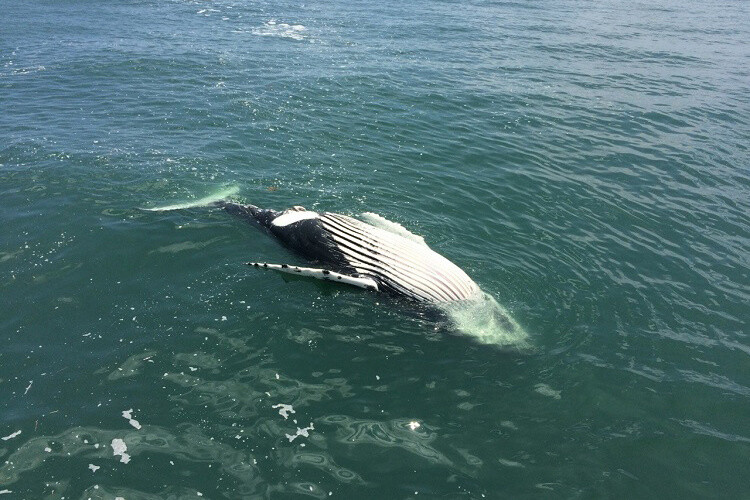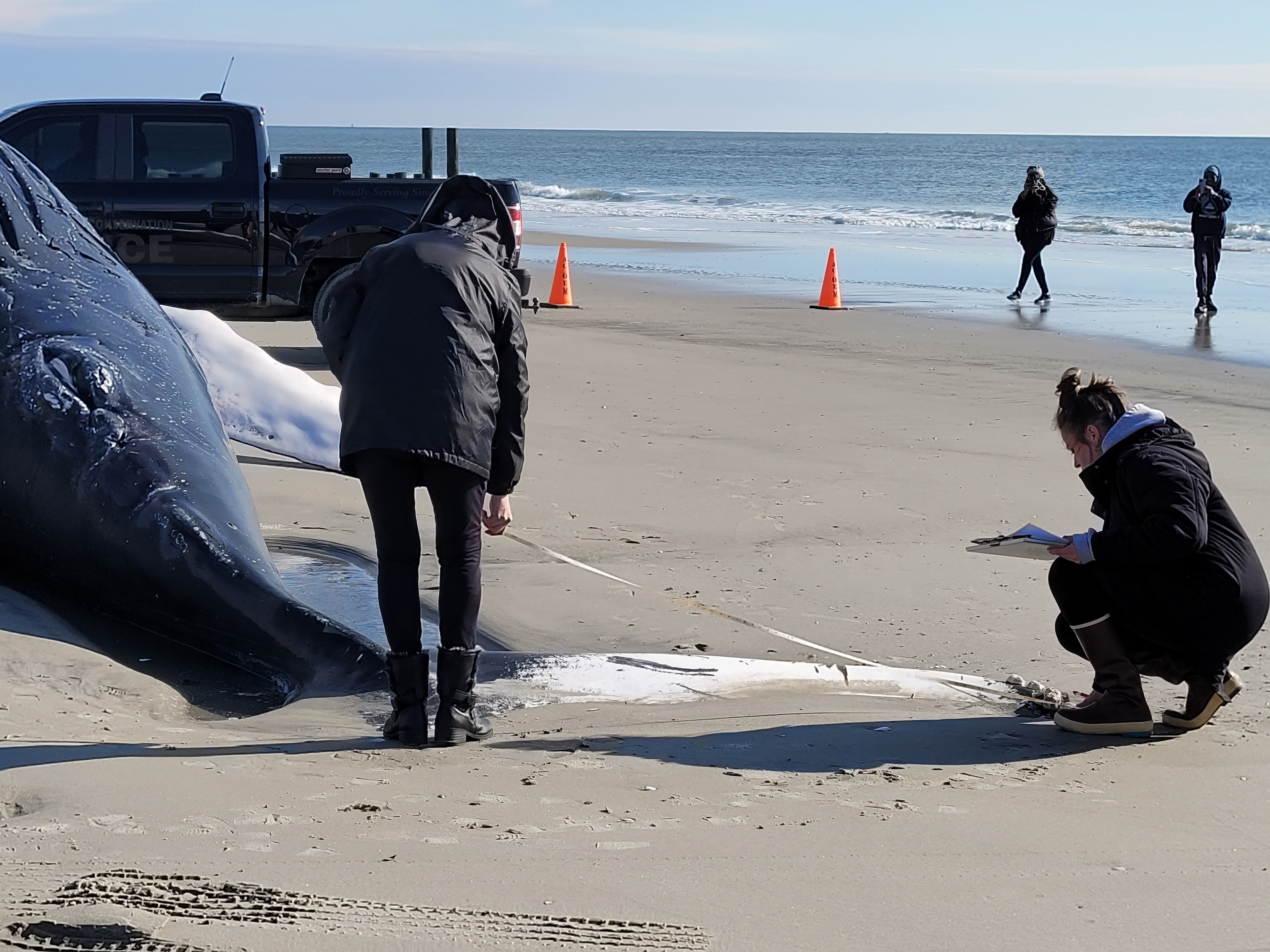Groups opposed to offshore wind energy developments called on federal officials to suspend all survey work on those projects off New Jersey and New York, and investigate recent humpback whale strandings including two dead juvenile whales that washed up at Atlantic City, N.J. two weeks apart.
The New Jersey-based environmental group Clean Ocean Action organized a Monday press conference at Atlantic City and a joint letter to President Biden, demanding a shutdown of all offshore wind development activity in the New York Bight pending an investigation into “the unprecedented number of dead, predominately juvenile, whales washing-up in the last 33 days on the New Jersey/New York coastline.”
“Six whales washing-up on the New Jersey/New York coastline in just over a month is unprecedented,” the groups wrote. “As concerning, none of the whales exhibited obvious causes of death such as ship strikes, entanglements, or predator attacks. With one major exception, no clear differences can explain or suggest this alarming number of deaths in the region.
“The exception is the ongoing geological seafloor-mapping and surveying and other pre-construction and construction actions by numerous offshore wind energy developers.”
The groups’ demands follow the washup of a dead juvenile humpback whale in Atlantic City Jan. 7. A humpback whale of similar age was found dead in Atlantic City Dec. 23.
Other incidents included another dead humpback about 20 miles south at Strathmere, N.J., Dec. 10. On Dec. 13 a juvenile sperm whale stranded at Rockaway Beach in Queens, N.Y., and died despite a rescue effort by surfers and construction workers on a seawall project.
Specialists from the nonprofit Marine Mammal Stranding Center, based in nearby Brigantine, N.J., responded to the Atlantic City strandings to examine the dead animals, perform necropsies and collect tissue samples before the carcasses were buried on the beach.
The National Oceanic and Atmospheric Administration has been tracking a trend of elevated humpback deaths since 2016 – what it calls an “unusual mortality event.”
“This UME began prior to any offshore wind activities in the Atlantic Ocean. To date, there are 174 humpback whales included in the UME” according to the latest tally, said Lauren Gaches, a NOAA spokeswoman, in and email statement.
“Partial or full necropsy examinations were conducted on approximately half of the whales. Of the whales examined, about 40 percent had evidence of human interaction, either ship strike or (fishing gear) entanglement. To date, no humpback whale mortality has been attributed to offshore wind activities.”
The groups calling for a federal investigation – Clean Ocean Action, Protect Our Coast NJ, Save Long Beach Island, Long Island Commercial Fishing Association, and Defend Brigantine Beach – say the timespan being studied by NOAA lines up with survey work for offshore wind, including acoustic surveys.
Specifically the groups called for:
- An immediate investigation into the marine mammal mortalities by the National Marine Fisheries Service and “most importantly overseen by a truly independent team of marine mammal scientists who are experts in marine mammal physiology, biology, and behavior. Independent international experts should also be consulted. The investigation must be fully transparent to the public, including investigation status, the activities of the investigation, and the reports.”
-A halt to all offshore wind energy development activity within the Atlantic Ocean between Cape May, N.J., and Montauk Point, N.Y., “including assessment, characterization, and construction related activities until an assessment. The cessation should remain in place until an assessment, including the required monitoring activities, of the cause of these marine mammal deaths is determined. If offshore wind energy activities are deemed a cause, the moratorium should continue until stringent protection measures are established.”
- “A full-stop on any new, pending, and planned offshore wind permitting, leasing activities, solicitations, power purchase agreements, consistency reviews, and other offshore wind development activities” in the New York Bight “until an assessment of the cause of these marine mammal deaths is determined and publicly agreed upon measures can be enacted.”
U.S. offshore wind developments are advancing in the region from southern New England to New Jersey, with ongoing survey and geophysical work to map out construction sites and probe the seabed. Closest to Atlantic City are Ørsted’s Ocean Wind 1 project, and a few miles to the north Atlantic Shores, backed by Shell New Energies and EDF Renewables.
The groups say they want to see release of all wind farm survey vessel “logs, data, equipment and real-time sound data and activities for the Ocean Wind 1 and Atlantic Shores windfarms, including information on whale sightings, vessel strikes, near misses and avoidance details.”
On the bigger coastwide scale, “never in human history has such a fast-paced industrialization of an ocean ecosystem taken place. The cumulative effect of this many offshore wind energy projects will devastate ocean habitat and harm multitudes of marine life,” the groups’ letter says. “Currently, there are 25 offshore wind projects underway in the NY/NJ region with more sought by the New Jersey Board of Public Utilities in its third, and largest, solicitation for offshore wind energy.”
In a joint statement from Atlantic City, the activist groups – including residents from New Jersey beach towns who oppose the wind development – said survey activity on the wind developers’ federal lease areas pose danger to whales from vessel collision and underwater noise from acoustic surveys.
“The premature death of so many whales and other marine mammals is an untenable situation that we believe is most likely caused by the increase in vessel traffic and the ‘sounding’ or mapping of the ocean floor by several offshore wind project developers,” said Suzanne Hornick of the local group Protect our Coast NJ.
Clean Ocean Action contends its tally shows offshore wind companies operate under “incidental take permits” issued by NMFS under the federal Marine Mammal Protection Act that allow their operations to affect up to 157,328 marine mammals.
Permits allow operarators to “harm, harass, injure and kill for current and pending offshore wind projects. These animals are not individually hit once, they may be the same animals subjected to impacts again and again with all the activity going on offshore,” said Kari Martin, advocacy campaign manager for Clean Ocean Action.
Permits are required for any offshore activity that can have effects on protected species. But Gaches of NOAA said the agency “has not issued any incidental take authorization that authorizes the mortality or injury of any marine mammal incidental to offshore wind activities.”





